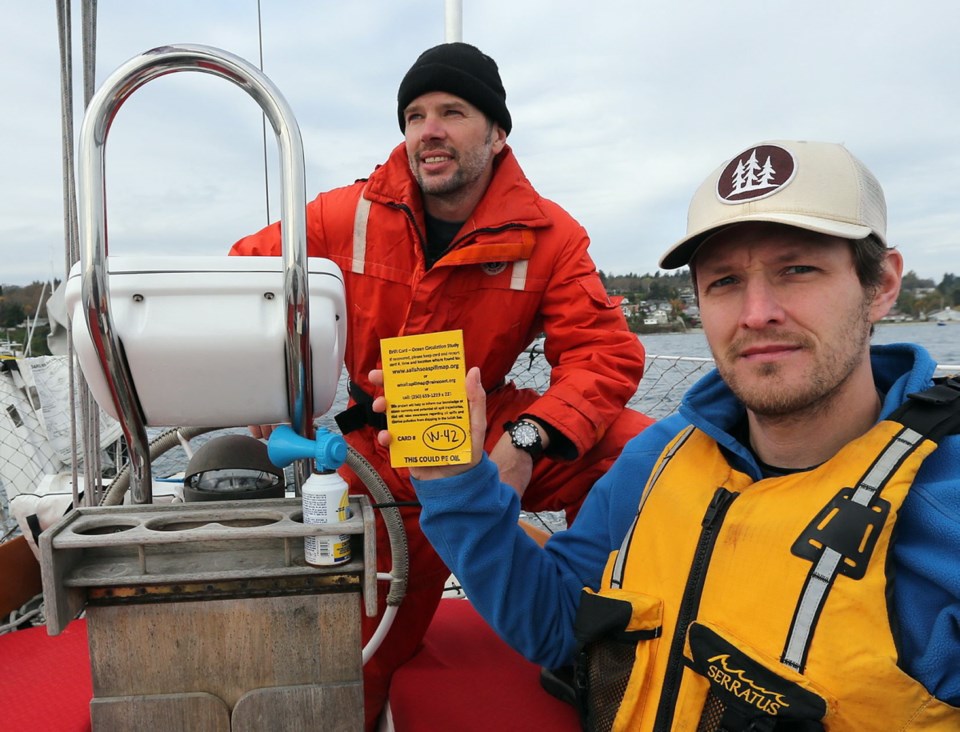Melissa Frey and a group of friends were walking along the beach on Saturna Island recently when they spotted yellow pieces of plywood stamped with a simple message: This could be oil.
The “drift cards” are part of a joint study by the Raincoast Conservation Foundation and the Georgia Strait Alliance to look at the potential spread of an oil spill in the Salish Sea. Each card states the purpose of the study and asks those who find them to contact the organization so they can plot the location on a map at salishseaspillmap.org.
“We’d heard of the study so we weren’t too surprised to see them,” said Frey, a Victoria biologist. “But it was a big cluster that washed up and it wasn’t lost on us that we were in a national park.”
Coincidentally, her husband found the first card on Victoria shores Tuesday at Clover Point. It travelled from the mouth of the Fraser River in less than three days.
Nearly 2,000 cards were dropped between Oct. 24 and 30 along nine points from the Ironworkers Memorial Bridge in Vancouver to Juan de Fuca Strait off Victoria, mimicking a regular tanker route. The study is a direct response to the Kinder Morgan proposal for an expanded pipeline, which could increase oil-tanker traffic along the B.C. coast by five times. Based on data from Kinder Morgan, that could mean 408 annual tanker visits by 2017, up from 71 in 2010.
With increased traffic comes increased risk, said the organizations conducting the drift-card study. They said B.C. is not prepared for an oil spill, lacks liability coverage and doesn’t know how to deal with the diluted bitumen, a form of crude oil, carried in the tankers.
“The devastating impacts from an oil spill would be economic, ecological and social,” said Raincoast ecologist Misty MacDuffee. “The other worry is increased traffic. The vulnerability of the endangered population of southern resident killer whales is front and centre.”
The Ministry of Environment recently released the Westcoast Spill Response study by Nuka Research, which simulated spills in Dixon Entrance and the Juan de Fuca Strait. Even with favourable or average weather, the study concluded that less than half of the oil could be recovered from the water.
“There are some super tricky spots out here,” Ian Hinkle said while aboard his 33-foot sailboat in the choppy water at the mouth of Haro Strait. “And let’s be honest, most incidents on the sea happen because of human error.”
He noted the MV Coho ferry, which backed into a dock in Victoria Harbour last July after a 50-year perfect record. Then there was HMCS Winnipeg, damaged by a crash with a fishing trawler in Esquimalt Harbour in April. In 2009, the bulk carrier Hebei Lion had a close call when it was blown onto a reef off Mayne Island. Not so lucky was the Tua Hai, a Chinese freighter that sunk after colliding with a Japanese trawler off the northern coast of Washington in 1991, spilling hundreds of thousands of gallons of fuel into the ocean.
Hinkle, a filmmaker who works with Raincoast Conservation, took researcher Andy Rosenberger and the last bin of biodegradable cards out to sea Wednesday. Birds bobbed on the waves, a seal poked up for a snoop and a cargo ship and tanker grew closer on the horizon as the last 200 cards drifted away. When Raincoast did a card drop a few days earlier from their 70-foot sailboat Achiever, they brought along a group of high school students from Saltspring Island and saw a humpback whale.
“We’ll be sharing our data and hopefully it does promote interest,” Rosenberger said. “You can do all the oil-spill preparedness you want, but if it’s blowing gales out there it won’t help.”
The Environment Ministry confirmed it is aware of the drift card study and is interested in the findings.
Mike Davies, senior director of marine development with the Kinder Morgan Trans Mountain Expansion Project, said the company is in the midst of marine life and environmental impact studies as part of its proposal.
“We understand that probability of a marine incident is an important discussion, and we are committed to addressing these concerns in our application to the National Energy Board,” Davies said in an email, adding the company welcomes public feedback and questions.



